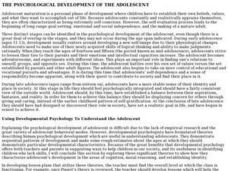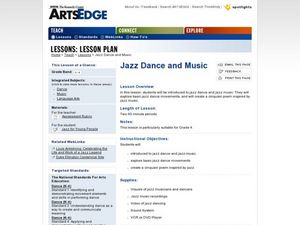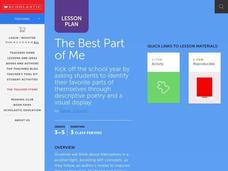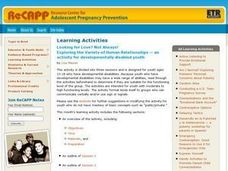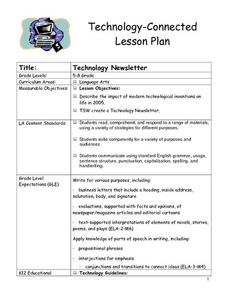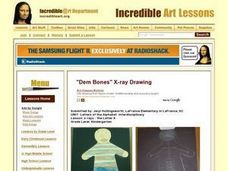Curated OER
Digging for Treasure: Note-Taking Skills for Primary Children
Second graders study the criteria for biographies and the vocabulary that is specific person and time. They take notes, write e-mail and gather information on a famous person.
Curated OER
The Physiological and Psychological Development of the Adolescent
Students examine the life of a teenager from their own perspective and an adult's. In groups, they focus on the biological changes and how they are different in a girl and a boy. Individually, they write a paper about these changes and...
Curated OER
Creating Characters
Students examine the methods of effective characterization. In this writing skills lesson, students discuss how emotions, dialogue, actions, and physical descriptions build believable characters. Students then use the methods of...
Curated OER
Architecture: Homes All Around
Students listen to a book, "This is My House" and sing a song to the tune of Home on the Range. They use the internet to view examples of Frank Lloyd Wright's architecture. Students take pictures of architectural details of their homes...
Curated OER
When Building Up Leads to Breaking Down
Students examine where one develops his or her views about health and ways in which teen-agers exhibit these influences, focusing particularly on the rising trend of anabolic steroid use in teen-age girls.
Curated OER
Jazz Dance and Music
Fourth graders write a poem. In this jazz music lesson, 4th graders learn about the basics of jazz dance and practice basic movements. Students learn common terminology and listen to several recordings of jazz music. Students create a...
Curated OER
Don't Burn, Baby, Burn!
Students consider products that provide protection from sunburn and other negative effects of the sun's ultraviolet rays. They develop or improve upon sun-screening products that are meant to provide protection for populations at risk...
Curated OER
Food for Thought: Hunger???Around the Block, Around the World LESSON 2: Local Hunger and Malnutrition
Students examine the difference between hunger and malnutrition. They study the idea of hunger as a theme in literature while discovering how communities can solve hunger problems.
Curated OER
Performing the Heimlich Maneuver
Students perform the Heimlich Manuever. In this first aid instructional activity, students read about choking and the Heimlich Maneuver. Students learn when and how to perform the Heimlich Maneuver.
Curated OER
Best Part of Me
Students determine a positive physical feature of themselves. They participate in an online writer's workshop and write descriptive poem about their favorite feature. They create a display of poetry and pictures.
Curated OER
T-shirts Build School & Community Pride
Students explore ways to promote community pride by creating t-shirts. In this community lesson, students utilize a digital camera to take photographs of their hometown and transfer them to a t-shirt. Students complete a...
Curated OER
Looking for Love? Not Always! Exploring Human Relationships
Students research psychology by examining real life situations. In this human relationships lesson, students discuss the importance of respect among two people in a romantic relationship. Students examine images of people in...
Curated OER
Technology Newsletter
Students discuss impact and value of modern technological inventions on society, contemplate world without technology, skim magazines and newspapers for advertisements highlighting modern technologies, and work with partner to create...
Curated OER
There's a Monster in My Classroom
Students work in groups making drawing of monsters and then given written instructions to students in another class about how to draw the same monster. After the drawings are complete, they share with other students using an iSight...
Curated OER
Image Conscious
Students take a stand on the concept of changing their appearance. In this changing of ones image instructional activity, students create a design that would change their image and discuss the age they think they...
Curated OER
x-rays - the Letter X
Students demonstrate the ability to draw vertical, horizontal, and diagonal lines, recognize the difference between inside and outside, and create a picture of themselves.
Curated OER
The Wind Blew
Students look at a picture book and observe what the facial expressions show. In this character's feelings lesson, students write what they think the character might be saying on each page and the punctuation they use. ...
Curated OER
Lessons from the Holocaust
Students discover what a dictatorship is by examining the holocaust. In this government instructional activity, students discuss the laws that were enacted for Nazis to take control of Germany, and the types of laws we have put...
Curated OER
Enough About I — Let’s Talk About Me
Young scholars review parts of speech and share informative usage presentations to their classmates. In this grammar lesson plan, students discuss the importance of using appropriate speech and then read "The I's Have It." Young scholars...
Curated OER
Poke and Look Learning Books
Young scholars read Poke and Look Learning Books and complete predicting activities, reading, questioning, and more. In this Poke and Look Learning Books, students do this for 13 different books.
Curated OER
Famous Authors Vocabulary Quiz
Audience, novel, plot, style. Young readers are asked to match words associated with literature to the provided definitions. Might be fun to use as part of a literature review contest.
Curated OER
Nutrients
Fourth graders discuss whether they ate breakfast and if so, did their breakfast contain all that their body needs until lunch time. They talk about the definition of nutrients and that every part of their body needs water. They also...
Curated OER
Building a Circulation City
Students identify the different organ systems found throughout the human body. Using a model, they explain and draw the flow of blood and name the parts of the circulatory system. They create their own circulation city in which to show...
Curated OER
All About Me: My Senses
Students explore the world around them and identify their five senses and the parts of their bodies that are associated with each sense.



